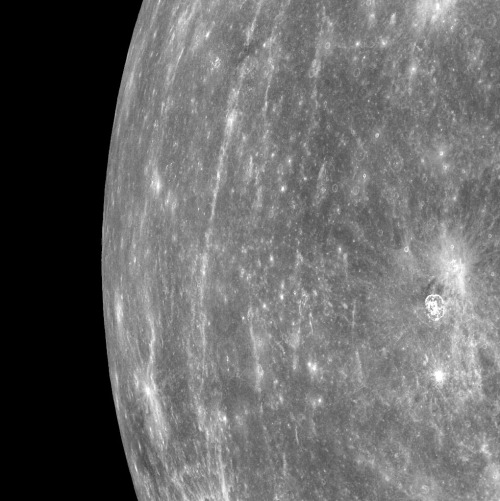WASHINGTON (AFP) ― NASA scientists pored Wednesday over stunning new images of Mercury as their MESSENGER probe began a year-long mission to map the surface of the solar system’s least-understood planet.
After a 7.9-billion-kilometer journey that took six-and-a-half years, the Mercury Surface, Space Environment, Geochemistry, and Ranging spacecraft finally entered the planet’s orbit on March 17.
MESSENGER could unlock the secrets of a planet where temperatures reach a mind-boggling 427 degrees Celsius during the day but plummet to minus 100 degrees Celsius at night.
Despite its relative proximity to the Earth, Mercury has been little explored because it is the closest planet to the Sun and therefore subject to enormous gravitational pulls and massively high levels of radiation.
After a 7.9-billion-kilometer journey that took six-and-a-half years, the Mercury Surface, Space Environment, Geochemistry, and Ranging spacecraft finally entered the planet’s orbit on March 17.
MESSENGER could unlock the secrets of a planet where temperatures reach a mind-boggling 427 degrees Celsius during the day but plummet to minus 100 degrees Celsius at night.
Despite its relative proximity to the Earth, Mercury has been little explored because it is the closest planet to the Sun and therefore subject to enormous gravitational pulls and massively high levels of radiation.

The first image, released on Tuesday, showed a dark crater called Debussy, while the lower part revealed a portion of Mercury near its south pole that has never before been photographed by a spacecraft.
MESSENGER, the first spacecraft ever placed in Mercury’s orbit, captured 363 more images over six hours, 224 of which had been transmitted back to eager NASA scientists by Wednesday afternoon.
“Mercury has many mysteries, and now we will be able to get the close-up information that will unlock these secrets,” said James Head, a geological sciences professor who is part of the MESSENGER team.
“In the coming year, we will be making discoveries every day, answering old questions and revealing new mysteries that we can’t even suspect today.
“On Earth, we don’t understand how plate tectonics started several billion years ago. Mercury may hold the answer,” Head said.
“We also want to know that if the material in the permanently shadowed craters on Mercury is water ice, how does it get there in this hellishly hot environment? Could this be a record of the history of water in the solar system?”
Mariner 10, an earlier probe that made three passes of Mercury in 1974 and 1975, mapped out about 45 percent of the surface of the planet. NASA hopes now to be able to complete that work.
MESSENGER will begin continuous mapping on April 4, orbiting the planet every 12 hours at a minimum altitude of 200 kilometers.
Scientists believe enormous volcanic eruptions produced many of Mercury’s expansive plains, which are littered with meteor craters, and say its strong magnetic field appears to be generated by a molten iron core.
MESSENGER, a 485-kilogram robotic probe, was launched in August 2004, making one flyby of Earth, two of Venus and three of Mercury before entering its new orbit.
”The entire MESSENGER team is thrilled that spacecraft and instrument checkout has been proceeding according to plan,“ said mission spokesman Sean Solomon of the Carnegie Institution for Science in Washington.
“The first images from orbit and the first measurements from MESSENGER’s other payload instruments are only the opening trickle of the flood of new information that we can expect over the coming year. The orbital exploration of the solar system’s innermost planet has begun.”
Named after the Roman messenger god, hence the name of the NASA probe, Mercury is heavily cratered and similar in appearance to the Moon. It is the smallest of the eight planets and orbits the Sun every 87.969 Earth days.












![[Today’s K-pop] BTS pop-up event to come to Seoul](http://res.heraldm.com/phpwas/restmb_idxmake.php?idx=644&simg=/content/image/2024/04/17/20240417050734_0.jpg&u=)




![[KH Explains] Hyundai's full hybrid edge to pay off amid slow transition to pure EVs](http://res.heraldm.com/phpwas/restmb_idxmake.php?idx=652&simg=/content/image/2024/04/18/20240418050645_0.jpg&u=20240418181020)

![[Today’s K-pop] Zico drops snippet of collaboration with Jennie](http://res.heraldm.com/phpwas/restmb_idxmake.php?idx=642&simg=/content/image/2024/04/18/20240418050702_0.jpg&u=)